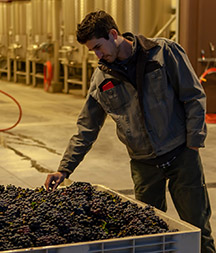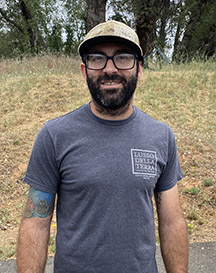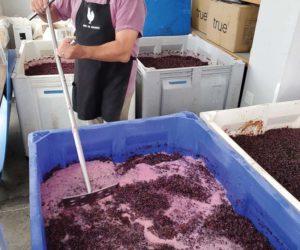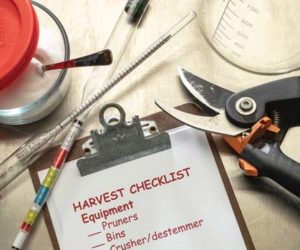Sure, most home winemakers don’t have the fancy, large-scale presses the pros use, but a lot can still be gleaned from how they do things. We asked three pros to share their pressing practices and best pressing advice for hobbyists.

John Musto is the Winemaker for Drive Wines in Santa Rosa, California
For most of our wine production we use a 1,320-gallon (50-hL) pneumatic bladder press, although we continue to use a small basket press for experimental lots. We do a programmed press run that is a bit different for our reds versus our rosé or white wines. For reds, the program starts by allowing free-run juice through, eventually assisted by tumbling the lot. Once this cycle is complete, we slowly ramp up pressure in increments of 0.2 bar, tumbling between each cycle. We will press a typical red lot until 0.8/1.0 bar depending mainly on taste, but also based on familiarity with the vineyard, our anticipated oak regimen, and the varietal. Our rosé/white process is similar, but dealing with whole clusters and looking to produce a lighter style of wine, we use a slightly different program that runs lighter press cycles. We typically run this program up to 0.4/0.6 bar.
Originally, we kept our free run and press lot separate, but we quickly realized blended wine helped develop a more complete and balanced wine than the separated lots. We find that our free-run juice on its own will miss this added structure, especially in the mid-palate. As a result, we now taste throughout the pressing, especially as pressure increases and make a decision as to whether this will be included with our final blend. This allows us to ensure that no overly tannic or astringent wine makes it into our blend as later pressing will eventually bring in astringency from the pips. Blending the wine early on allows us to bring individual elements together to develop a balance of fruit and structure before elevage. There are obvious logistical benefits to keeping the lot homogenized as well.
We whole-cluster press our rosé (while we haven’t made a white yet, we will whole cluster press them as well and we’re hopeful 2022 will be the year!) to give them a lightness and freshness. Our style has always been to make lighter, acid-driven rosé and whole cluster pressing within hours of the pick allows us to accomplish this. Looking forward, we may implement some light foot treading to add color and body to our whites/rosés, but we very much like the clean style that results from the vin gris method of rosé production.
Pressing for a home winemaker is not all that different — the most important part of pressing is to constantly taste and evaluate the juice. With anything in winemaking, the more you’ve tasted, the better you understand what to look for. This is true no matter the size of your production. A basket press will build up more pressure than a bladder press, so the evaluative step is even more critical in ensuring any undesirable pressed wine doesn’t make it into your final blend.
Tasting throughout and making notes will help you during the press cycle as much as any stage in winemaking. Evaluative decisions made at the press may ultimately have the biggest impact on the final wine (pick timing being a possible exception). This will also help to be a barometer for future pressings, especially if working with the same lots. When tasting, be sure to observe flavor profile, structure (looking out for astringency), color, acid, and residual sugar.
A final thing to remember is that wood is porous so it’s less than ideal from a sanitation perspective. Ensure that you are keeping an organized cleaning and sanitation program, making sure the press is dry when you place it into storage.

Edward Cholakian is a Winemaker at Wolfe Heights Estates in Sacramento, California
The style of each particular wine determines how we will press grapes in our Diemme AR50 bladder press, which is 1,320 gallons (50 hL) in size. Our white/red whole cluster grape press program starts by inflating to 0.2 bar, where it will hold pressure for 4–5 minutes before it will deflate the bladder and rotate the drum to break up the cake. It will continue to repeat the same steps but each stage will increase pressure by 0.2 bar until we reach the final pressure of 1.4 bar. In general for our red lots we will use a similar program but the final pressure can range from 1.6–1.8 bar. Our press cycles can go anywhere from 100 minutes to two hours.
We do separate free run and pressed juice on certain occasions at the winery. We will do this for our high-end red lots that we want to make certain stay soft, delicate, and approachable. The free run will be low in tannin and very fruity vs. the pressed juice, which will show more tannins, lower acids, and elevated potassium levels. By separating the free run and pressed juice it gives us more flexibility down the road when finishing the wine. A portion of the pressed juice can be blended back with the free run in order to achieve a more balanced wine. Separating press cuts is also very important to our sparkling wine program. The main reason we do it is so we are able to later adjust and use different fining and barrel aging techniques on the harder press fractions. In some cases certain cuts won’t make the final blend and can be used in a different wine or just as a blending component.
When to make a press cut is often best determined by taste. However, during harvest when things are busy around the winery it’s not always possible, so in those cases we will separate based on the pressure points. Once it hits our desired pressure we will collect what’s in the juice pan and switch tanks for the next fraction.
We do whole cluster presses for our white winemaking protocol and our rosé program. It is a gentle process that will extract less phenolics, will produce a less bitter and less astringent wine, and will show brighter aromatics.
Obviously home winemakers will be using significantly different equipment than we use. As the size of the pressing lots increase so will the equipment, but the concepts remain the same. My best advice to home winemakers when it comes to pressing is to constantly be tasting as the lots are pressing and document everything.

Marko Copic is the Owner and Winemaker at Purgatory Cellars Winery in Parker, Colorado
At Purgatory Cellars Winery we use a 3-ton press and for sediment a 53-gallon (200-L) bladder press. For some red wines we destem the grapes and try to move the whole berries into fermenters to get carbonic maceration using closed-top, stainless steel fermenters. Our primary fermentation is about 25–30 days, and then we will press the grapes. At pressing, we do not separate free-run and pressed juice for our wines, instead opting to collect all of the juice together. The reason for doing so is to keep the entire batch consistent, use less space in the winery, and because we are not producing wines where separating the runs would be so important (fresh wine with as little air contact as possible). These wines are then aged in 132-gallon (500-L) oak barrels and we put a focus on the fermentation process and aging by using supplements (such as Opti-White and Opti-Red, fermentation, cellaring and finishing tannins, and Glutastar), choosing the right yeast, strictly monitoring fermentation, and aging wine on the lees, all in an attempt to maximize extraction and preserving flavors.
We also use Georgian clay pots to make some red wines, which is the oldest winemaking technique in the world, probably started around 6000 B.C. After grapes are fermented and aged on the skins up to eight months, we empty the pots and drain without any pressing at all, using only the free-run wine.
My biggest suggestion for home winemakers regarding pressing is to use macerating enzymes for white grapes, such as Lallzyme Cuvée Blanc, as that will enhance pressing and release flavors.






